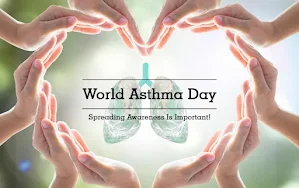World Asthma Day
World Asthma Day (3rd May 2022)
- Introduction
World Asthma Day has become one of the world’s most important asthma awareness and education events. For the 2022 World Asthma Day, GINA has chosen ‘Closing Gaps in Asthma Care' as the theme. World Asthma Day is aimed at bridging the gaps in asthma care. While timely intervention can help address “preventable suffering”, As per the World Health Organization (WHO), nearly 15 to 20 million people in India suffer from asthma, which includes patients from every age group (as of 2021).
- Definition
Bronchial asthma is a chronic airway disorder which can affect people of all age groups.
Asthma is defined as a chronic inflammatory disorder of airways which is associated with airway hyperresponsiveness. It leads to recurrent episodes of wheezing, breathlessness, chest tightness and
coughing, particularly at night or early morning. These episodes are usually associated with widespread
but variable airflow obstruction within the lungs that is often reversible either spontaneously or with
treatment. Appropriate treatment can also reduce the risk of further attacks.
- Epidemiology
In 2019 asthma affected approximately 262 million people and caused approximately
461,000 deaths. Prevalence of asthma varies considerably within countries and between countries. In
India, the prevalence of asthma has been found to be around 7% in the majority of surveys done.
However, it has been reported to vary from 2% to 17% in different study populations, the disease can
start at any age, but in a majority, it starts before 10 years of age. It is twice as common among boys
than girls, whereas in adults the male to female ratio is usually equal. It is more prevalent in developed
countries than developing ones.
PATHOLOGY
- Gross Appearance:
- Microscopic Appearance:
The main features of asthmatic airways include marked thickening of
basement membrane, bronchial smooth muscle hypertrophy and damaged epithelium, The bronchial
wall contains inflammatory cells and the most important cell is eosinophil. The mucus is often impacted
in the small airways in severe asthma.
Environment & Pollution
Asthma is usually worse on a cold and dry day, especially when there is a strong wind. Traffic pollution
can aggravate symptoms in asthmatic patients. Air pollutants such as Sulphur dioxide, ozone, diesel
particles can also precipitate asthmatic symptoms. Indoor air pollution is also an important trigger
factor. Cooking gas fumes and even passive cigarette smoking can trigger symptoms in asthmatic
subjects. Paints, sprays and fumes can also precipitate severe symptoms in patients with asthma.
The causes of asthma are not fully understood. Asthma is probably usually caused by a mixture of
hereditary factors (those you are born with) and environmental factors, but how these factors work
together is still largely unknown.
Signs & symptoms
Asthma is characterized by recurrent episodes of wheezing, shortness of breath,
chest tightness, and coughing. Sputum may be produced from the lung by coughing but is often hard to
bring up. During recovery from an asthma attack (exacerbation), it may appear pus-like due to high
levels of white blood cells called eosinophils. Symptoms are usually worse at night and in the early
morning or in response to exercise or cold air. Some people with asthma rarely experience symptoms,
usually in response to triggers, whereas others may react frequently and readily and experience
persistent symptoms.
Diagnosis is usually based on the pattern of symptoms, response to therapy over time, and spirometry
lung function testing. Asthma is classified according to the frequency of symptoms, forced expiratory
volume in one second (FEV1), and peak expiratory flow rate. It may also be classified as atopic or nonatopic, where atopy refers to a predisposition toward developing a type 1 hypersensitivity reaction.
Treatment Yes, that risk cannot be disregarded. Poorly treated asthma gets worse with age, and the
lungs of people with untreated asthma function less well than those of non-asthmatic individuals.
Modern asthma treatments have not been available for long enough for us to be certain whether or not
lung function will still deteriorate more rapidly in people with treated asthma as they grow older.
However, most asthma experts think, that regular, preventive asthma treatment can prevent your
asthma from getting worse and help to preserve your lung function.
- Prognosis
- Prevention
An effective plan should allow
you to:
1. Be active without having asthma symptoms.
2.Fully take part in exercise and sports. '
3.Sleep all
night, without asthma symptoms.
4.Attend school or work regularly.
5.Have the clearest lungs possible.
6.Have few or no side effects from asthma medicines.
7.Have no emergency visits or stays in the hospital




Comments
Post a Comment